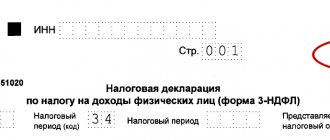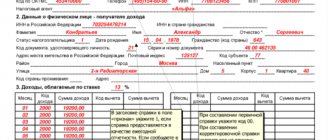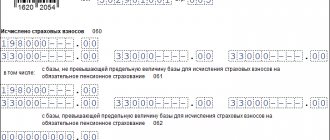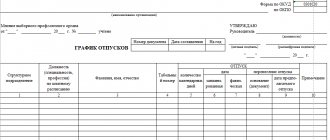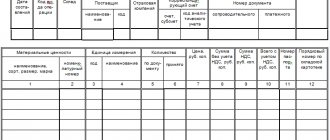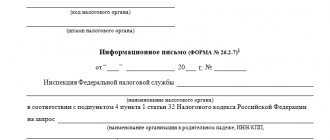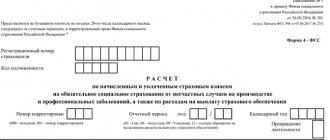Reporting form P-6 is intended to inform Rosstat about the financial investments and liabilities of a business entity. In 2021, the statistical report was changed, the current form was approved by Rosstat Order No. 400 dated July 21, 2020 (as amended on August 28, 2020). The same order provides detailed instructions on form P-6 (statistics). The updated form comes into force starting with the report for the 1st quarter of 2021; from that time on, the previous form (approved by Rosstat Order No. 421 dated July 24, 2019) is considered invalid.
New form P-6 from 2021
Form P-6 discloses information about the financial investments and liabilities of the enterprise. The standard that needs to be worked with when filling out form P-6 in 2021 is Rosstat order No. 421 dated July 24, 2019. It introduced a new form of form P-6 from January 1, 2020 (in Appendix 11) and provided instructions for filling it out.
The current form of form P-6 in 2021 can be downloaded for free via a direct link here:
FORM P-6 IN 2021
There are very few changes. Let's highlight them:
- commented on the procedure for submitting a report by the successor after the reorganization;
- added some concepts that are used when filling out Section 1 of the P-6 form (for example, cash pooling).
Appendix to the balance sheet is an important element of reporting
The importance of transcripts and explanations to the balance sheet cannot be overestimated.
The meager figures in accounting reports can tell the interested user little, and only in applications does this information appear in all its useful diversity. Form 5 is one such necessary application. The balance sheet is directly related to it: each line begins with the “Explanations” column, which indicates the numbers of the corresponding sections of Form 5.
Without filling out Form 5 as an appendix to the balance sheet, accounting will not always be able to fully fulfill its main function - to provide interested users (shareholders, investors, etc.) with important information about the financial position of the organization. But the scope of transcripts presented in this application may vary.
IMPORTANT! The opportunity to independently determine the level of detail of Form 5 is given to companies maintaining simplified accounting (clause 6 of the order “On the forms of financial statements of organizations” dated 07/02/2010 No. 66n).
For information about who has the right to prepare simplified statements, read the article “Simplified accounting financial statements - KND 0710096”.
If a company maintaining simplified accounting wants to minimize the amount of information in the appendices to the reporting, one should not forget that the simplified balance sheet, together with the explanations, must comply with the general requirements for reporting.
ConsultantPlus experts provided a step-by-step procedure for filling out Form 5. Check whether you filled out the report correctly using the Practical Guide to Annual Reporting from ConsultantPlus. If you do not have access to the K+ system, get a trial online access for free.
Read more about these requirements in the material “What requirements should accounting reporting satisfy?” .
Still have questions? You can consult on any of them on our forum! For example, here we look at the nuances of forming a liquidation balance sheet and its annexes.
Who is required to report on form P-6 in 2020
Form P-6 includes specific data that is not available in the activities of every enterprise. Therefore, not everyone must submit Form P-6 in 2020. Therefore, we will reflect on the diagram respondents of form P-6 and those who are not such:
If the organization does not have financial investments or borrowed funds, it is not necessary to provide a zero P-6 form.
Let us highlight some nuances regarding the presentation of form P-6:
- form P-6 is filled out as a whole for the legal entity without separating data from separate sections into separate reports;
- the successor after reorganization submits form P-6, taking into account the data of the reorganized company, starting from January of the year of reorganization.
On a general basis, legal entities must submit Form P-6:
Template changes
Statistical reporting forms change almost every year, so we recommend that you pay attention to the list of annual reporting templates that have been changed by Rosstat: use only the current ones:
- 11 “Information on the availability and movement of fixed assets (funds) and other non-financial assets”;
- 11 (transaction) “On transactions with fixed assets on the secondary market and their rental”;
- No. 11-FSS “On the service life of fixed assets”;
- No. 1-enterprise “Basic information about the activities of the organization”;
- 4-TER “On the use of fuel and energy resources”;
- 1-natura-BM “On production, shipment of products and balance of production capacity”;
- P-2 (investment) “On investment activities”;
- 12-F “On the use of funds”;
- 1-prices;
- 1-TORG “On the sale of goods by wholesale and retail trade organizations”;
- 1st round;
- 1-KSR “On the activities of collective accommodation facilities”;
- 1-T statistics 2021 (working conditions) “On the state of working conditions and compensation for jobs with harmful and (or) dangerous working conditions”;
- 3-inform “On the use of information and communication technologies and the production of computer equipment, software and the provision of services in these areas”;
- 4-innovation “On the innovative activities of the organization”;
- others.
Deadlines for submitting the report on form P-6 to Rosstat 2021
Form P-6 statistics refers to quarterly reporting. This applies to all categories of respondents, there are no differences.
The report submission date is the same - the 20th day of the month following the reporting period.
Let us present in table form the deadlines that must be met when reporting in Form P-6 in 2021:
| REPORTING PERIOD | DEADLINE IN 2021 |
| January – March 2021 | April 20, 2021 |
| January – June 2021 | July 20, 2021 |
| January – September 2021 | October 20, 2021 |
| January – December 2021 | January 20, 2021 |
Results
Form 5 (appendix to the balance sheet) details the balance sheet and allows users to provide the necessary information about individual types of assets and liabilities in a clear and accessible form. Not all of the tables included in it can be used, but only those that are necessary to disclose the figures shown in the balance sheet.
You can find more complete information on the topic in ConsultantPlus. Free trial access to the system for 2 days.
What to include in the tables of form P-6
When entering data into Form P-6, you should rely on accounting indicators.
Title page
The title must be filled in with information about the organization - name, postal address and OKPO.
Another item to fill out is the reporting period. Form P-6 is filled out with an accrual total. The first month of the period is always January. During the year, only the last month of the reporting period changes: March, June, September, December in reports, respectively, for the first quarter, for half a year, for 9 months, for the year.
Section 1
Section 1 of form P-6 is intended to reflect the financial investments and funds of the company.
What belongs to financial investments and what does not - we will show in the diagram:
Line 010 reflects the total amount of financial investments, broken down into long-term (line 020) and short-term (line 030). Further in the section, line 010 is detailed. From it, the following is distinguished:
The final lines (440-461) of Section 1 of Form P-6 reflect the amount of funds in the enterprise’s cash register and on current accounts - both in rubles and in foreign currency.
The columns of Section 1 reflect the dynamics of changes in financial investments during the reporting period, data at the beginning and end of the period, as well as the amount of income received.
Section 2
Section 2 includes data on borrowed funds.
Line 500 is filled in with the total amount of loans. The following is a line-by-line transcript according to their sources:
- bank loans,
- budget loans,
- loans received from other organizations,
- issued debt securities.
The columns reflect the dynamics of loans in the reporting period, similar to Section 1.
Section 3
Section 3 “Capital and reserves” is filled out only in the report for January-June, that is, based on the results of the six months. This includes data not from the current year, but from the previous year: at its beginning and at its end.
Section 3 reflects information about the authorized capital with detailed details (lines 710-790) and information about own shares purchased from shareholders (page 800).
The numbers in Section 3 of Form P-6 can be correlated with the numbers from the balance sheet:
| LINES OF SECTION 3 OF FORM P-6 | BALANCE BALANCE LINES |
| 700 "Capital and reserves" | 1300 “Total capital” |
| 710 -790 | 1310 “Authorized capital” |
| 800 “Own shares purchased from shareholders” | 1320 “Own shares purchased from shareholders” |
The report ends with a seal, the official’s signature and the date the report was signed.
How are the balance sheet and Form 5 related?
The amount of information in the appendix to the balance sheet (Form 5) depends on which lines are filled in the balance sheet. Let's explain this with an example.
LLC "Rhapsody" has been operating for 2 years, does not fall under the criteria of a small enterprise and prepares a balance sheet and all other reports, including Form 5 - an appendix to the balance sheet. Considering the period of operation of the company, the balance sheet figures will be presented for the current and previous periods.
| Explanations | Indicator name | Code | As of 12/31/20XX | As of 12/31/20XX | As of 12/31/20XX |
| ASSETS | |||||
| 2.1 | Fixed assets | 1150 | 320 | 200 | — |
| 4.1 | Reserves | 1210 | 80 | 90 | — |
| 5.1–5.2 | Accounts receivable | 1230 | 270 | 250 | — |
| 3.1 | Financial investments (excluding cash equivalents) | 1240 | 150 | 150 | — |
| ODDS | Cash and cash equivalents | 1250 | 200 | 210 | — |
| BALANCE | 1600 | 1 020 | 900 | — | |
| PASSIVE | |||||
| OIC | Authorized capital | 1310 | 15 | 15 | — |
| OFR, OIC | retained earnings | 1370 | 643 | 545 | — |
| 5.3–5.4 | Accounts payable | 1520 | 362 | 340 | — |
| BALANCE | 1700 | 1 020 | 900 | — | |
The code indicated in the “Explanations” column is the table number in Form 5.
But Form 5 to the balance sheet does not decipher all lines that have a numerical indicator. For example, it does not explain the line “Cash and cash equivalents”, so the link for explanations is given not to Form 1, but to the cash flow statement (CFDS).
Also, the specified appendix to the balance sheet does not decipher the indicators of the authorized capital and retained earnings - their detail is contained in other reports. Thus, the size of the authorized capital and retained earnings by period is reflected in the statement of changes in capital (OIC) and in the statement of financial results (OFR) in terms of net profit.
From 2021, all taxpayers are required to apply FAS 5/2019 “Inventories”, because PBU 5/01 is no longer in force. You can start applying the standard earlier by fixing the choice in the organization’s accounting policies.
ConsultantPlus experts explained in detail how to correctly disclose information about reserves in Form 5 when applying FAS 5/2019. To do everything correctly, get trial access to the system and go to the Ready solution. It's free.
In the example under consideration, form 5 will be filled out only for sections numbered 2, 3, 4 and 5. Let's look at the features of filling them out.
Read about the registration of ODDS and OIC in the article “Filling out forms 3, 4 and 6 of the balance sheet.”
An example of filling out form P-6 in 2020
Let Principle LLC be one of those firms that are required to submit form P-6 to the territorial statistics body and have indicators in the first quarter of 2021 to fill out the specified report.
At the beginning of 2021, Principle LLC had the following data on financial investments, loans and cash:
- long-term financial investments - a loan to a non-financial resident organization in the amount of 2000 rubles;
- short-term financial investments - bank deposit in a resident bank in the amount of 1000 rubles;
- cash in the cash register – 10,000 rubles;
- funds in the current account – 500,000 rubles;
- interest-free loan from a resident non-financial organization in the amount of RUB 200,000.
During the first quarter, the following occurred at Princip LLC for transactions that are reflected in P-6:
- interest accrued on a long-term loan - 50,000 rubles;
- interest accrued on the deposit - 20,000 rubles;
- received/departed from/to the cash register – RUB 100,000/RUB 95,000;
- received/departed from the current account – 900,000 rubles/750,000 rubles.
Below is a sample of a completed P-6 form in 2021 for the specified example, and below it can be downloaded for free.
Responsibility for failure to provide statistical reporting
For failure to provide or untimely provision of statistical data by companies and individual entrepreneurs to Rosstat bodies, the sanctions of Article 13.19 of the Code of Administrative Offenses of the Russian Federation provide for an administrative fine in the amount of:
- from 10,000 to 20,000 rubles - for officials;
- from 20,000 to 70,000 rubles - for legal entities.
Repeated commission of such an administrative offense will entail an administrative fine for officials in the amount of 30,000 to 50,000 rubles, and for legal entities - from 100,000 to 150,000 rubles. Similar liability is provided for the provision of false indicators to statistics.
